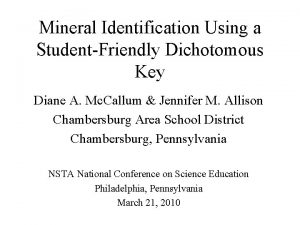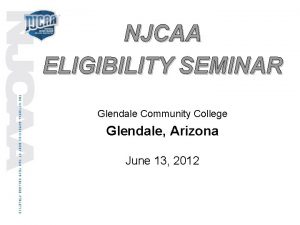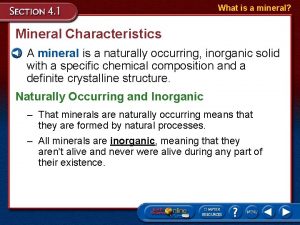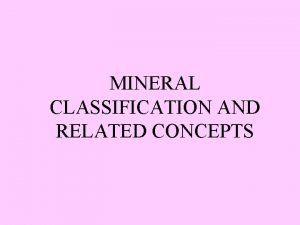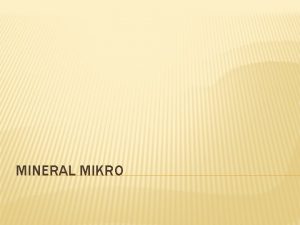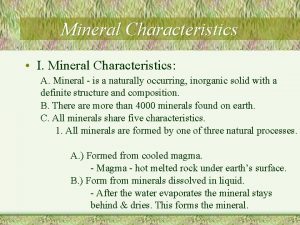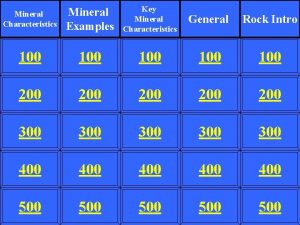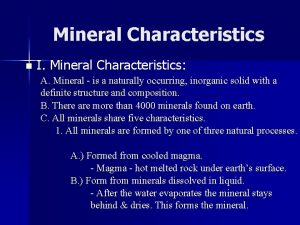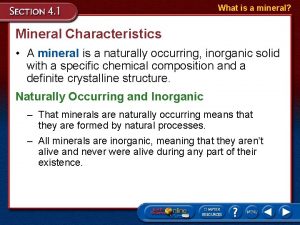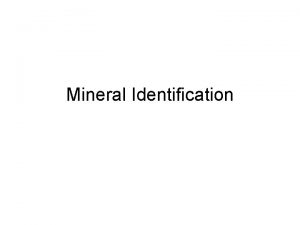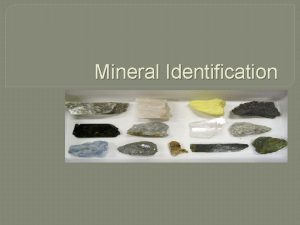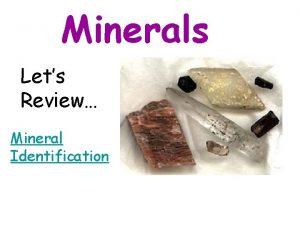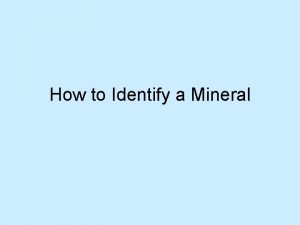WELCOME TO THE GLENDALE COMMUNITY COLLEGE MINERAL IDENTIFICATION































- Slides: 31

WELCOME TO THE GLENDALE COMMUNITY COLLEGE MINERAL IDENTIFICATION PROGRAM presented by: Susan Celestian - Curator of the Arizona Mining and Mineral Museum Stan Celestian - Photographer © copyright 2002

TABLE OF CONTENTS This is the second part of Mineral Identification Program Crystals…………………. … 4 Isometric………………. …. . 6 Hexagonal………………. … 10 Tetragonal…………………. 14 Orthorhombic……………. . …. 18 Monoclinic………………. . . 23 Triclinic………………… 26 Resources…………………. 29

Introduction to Mineral Identification Basics Welcome to the fascinating world of Minerals. The purpose of this CD is to present you with some of the basic techniques used to identify minerals. This Power Point Presentation can also be viewed in the “edit” mode. Here you can view the many notes associated with the slides.

Mineral Identification Basics n PHYSICAL PROPERTIES CRYSTALS A CRYSTAL is the outward form of the internal structure of the mineral. The 6 basic crystal systems are: ISOMETRIC TETRAGONAL Drusy Quartz on Barite MONOCLINIC HEXAGONAL ORTHORHOMBIC TRICLINIC

Mineral Identification Basics n PHYSICAL PROPERTIES CRYSTAL SYSTEMS are divided into 6 main groups. The first group is the ISOMETRIC. This literally means “equal measure” and refers to the equal size of the crystal axes. ISOMETRIC - Fluorite Crystals

Mineral Identification Basics n ISOMETRIC CRYSTALS a 3 ISOMETRIC a 2 In this crystal system there are 3 axes. Each has the same length (as indicated by the same letter “a”). They all meet at mutual 90 o angles in the center of the crystal. a 1 ISOMETRIC Basic Cube Crystals in this system are typically blocky or ball-like.

Mineral Identification Basics n ISOMETRIC CRYSTALS Within this ISOMETRIC crystal model is the OCTAHEDRAL crystal form (yellow) and the TETRAHEDRAL crystal form (shown by the black lines). ISOMETRIC Crystal Model

Mineral Identification Basics n ISOMETRIC CRYSTALS a 3 a 2 a 1 ISOMETRIC - Basic Cube Fluorite cube with crystal axes.

Mineral Identification Basics n ISOMETRIC BASIC CRYSTAL SHAPES Spinel Octahedron Garnet Trapezohedron Fluorite Cube Garnet - Dodecahedron Pyrite Cube with Pyritohedron Striations

Mineral Identification Basics n HEXAGONAL CRYSTALS c a 3 a 2 a 1 HEXAGONAL - Three horizontal axes meeting at angles of 120 o and one perpendicular axis. HEXAGONAL Crystal Axes

Mineral Identification Basics n HEXAGONAL CRYSTALS HEXAGONAL This model represents a hexagonal PRISM (the outside hexagon - six sided shape). The top and bottom faces are called PINACOIDS and are perpendicular to the vertical “c” axis. Within this model is the SCALENOHEDRAL form. Each face is a scalenohedron. Calcite often crystallizes with this form. HEXAGONAL Crystal Model

Mineral Identification Basics n HEXAGONAL CRYSTALS These hexagonal CALCITE crystals nicely show the six sided prisms as well as the basal pinacoid.

Mineral Identification Basics n Prism Faces HEXAGONAL CRYSTALS Pyramid Faces Pyramid Face Prism Faces Dolomite RHOMBOHEDRON Vanadinite Hanksite Rhodochrosite SCALENOHEDRON Quartz

Mineral Identification Basics n TETRAGONAL CRYSTALS TETRAGONAL c Two equal, horizontal, mutually perpendicular axes (a 1, a 2) a 1 a 2 Vertical axis (c) is perpendicular to the horizontal axes and is of a different length. c TETRAGONAL Crystal Axes a 1 a 2 This is an Alternative Crystal Axes

Mineral Identification Basics n TETRAGONAL CRYSTALS TETRAGONAL This model shows a tetragonal PRISM enclosing a DIPYRAMID. TETRAGONAL Crystal Model

Mineral Identification Basics n TETRAGONAL CRYSTALS WULFENITE Same crystal seen edge on.

Mineral Identification Basics n TETRAGONAL CRYSTALS This is the same Apophyllite crystal looking down the “c” axis. APOPHYLLITE on Stilbite The red square shows the position of the pinacoid (perpendicular to the “c” axis).

Mineral Identification Basics n ORTHORHOMBIC CRYSTALS ORTHORHOMBIC Three mutually perpendicular axes of different lengths. c c a b ORTHORHMOBIC Crystal Axes a b An Alternative Crystal Axes Orientation

Mineral Identification Basics n ORTHORHOMBIC CRYSTALS ORTHORHOMBIC This model shows the alternative axes where the vertical “c” axis is not the longest axis. ORTHORHMOBIC Crystal Model The model shows the outside “brick” shape of the PRISM and the inner shape is a DIPYRAMID. The top and bottom faces are called PINACOIDS and are perpendicular to the “c” axis.

Mineral Identification Basics n ORTHORHOMBIC CRYSTALS Topaz from Topaz Mountain, Utah.

Mineral Identification Basics n ORTHORHOMBIC CRYSTALS BARITE is also orthorhombic. The view above is looking down the “c” axis of the crystal.

Mineral Identification Basics n ORTHORHOMBIC CRYSTALS Pinacoid View Prism View STAUROLITE

Mineral Identification Basics n ORTHORHOMBIC CRYSTALS This is a Staurolite TWIN with garnets attached.

Mineral Identification Basics n MONOCLINIC CRYSTALS c MONOCLINIC b a In this crystal form the axes are of unequal length. Axes a and b are perpendicular. Axes b and c are perpendicular. MONOCLINIC Crystal Axes But a and c make some oblique angle and with each other.

Mineral Identification Basics n MONOCLINIC CRYSTALS MONOCLINIC In this model the outside shape is the PRISM. It looks like a distorted brick flattened out of shape. Inside is the DIPYRAMID. MONOCLINIC Crystal Model

Mineral Identification Basics n MONOCLINIC CRYSTALS Top View Gypsum Orthoclase Mica

Mineral Identification Basics n TRICLINIC CRYSTALS c TRICLINIC a b TRICLINIC Crystal Axes In this system, all of the axes are of different lengths and none are perpendicular to any of the others.

Mineral Identification Basics n TRICLINIC CRYSTALS TRICLINIC Again in this model the outside shape is the PRISM. Located within the prism is the DIPYRAMID. TRICLINIC Crystal Model

Mineral Identification Basics n TRICLINIC CRYSTALS Microcline, variety Amazonite

Mineral Identification RESOURCES For lots of useful images of minerals and more facts about minerals, check out this web site: http: //www. gc. maricopa. edu/earthsci/imagearchive/index. htm

This copyrighted Power Point CD was produced strictly for educational purposes. Any attempt at using the images within this program for monetary gain is illegal. The authors have given permission to use the program or parts of it, provided. THE credit is given to the Arizona Mining and Mineral Museum, its Curator - Susan Celestian and the photographer Stan Celestian. END
 Glendale community college library
Glendale community college library Gcc csu breadth
Gcc csu breadth Glendale city college nursing
Glendale city college nursing Dual enrollment gcc
Dual enrollment gcc Glendale community college transcript
Glendale community college transcript Mineral dichotomous key
Mineral dichotomous key Central pocket vs plain whorl
Central pocket vs plain whorl Welcome welcome this is our christmas story
Welcome welcome this is our christmas story City of glendale utilities
City of glendale utilities Incarnation church glendale
Incarnation church glendale Hát kết hợp bộ gõ cơ thể
Hát kết hợp bộ gõ cơ thể Frameset trong html5
Frameset trong html5 Bổ thể
Bổ thể Tỉ lệ cơ thể trẻ em
Tỉ lệ cơ thể trẻ em Chó sói
Chó sói Chụp phim tư thế worms-breton
Chụp phim tư thế worms-breton Hát lên người ơi alleluia
Hát lên người ơi alleluia Môn thể thao bắt đầu bằng từ đua
Môn thể thao bắt đầu bằng từ đua Thế nào là hệ số cao nhất
Thế nào là hệ số cao nhất Các châu lục và đại dương trên thế giới
Các châu lục và đại dương trên thế giới Công thức tính thế năng
Công thức tính thế năng Trời xanh đây là của chúng ta thể thơ
Trời xanh đây là của chúng ta thể thơ Mật thư tọa độ 5x5
Mật thư tọa độ 5x5 Phép trừ bù
Phép trừ bù độ dài liên kết
độ dài liên kết Các châu lục và đại dương trên thế giới
Các châu lục và đại dương trên thế giới Thơ thất ngôn tứ tuyệt đường luật
Thơ thất ngôn tứ tuyệt đường luật Quá trình desamine hóa có thể tạo ra
Quá trình desamine hóa có thể tạo ra Một số thể thơ truyền thống
Một số thể thơ truyền thống Cái miệng nó xinh thế chỉ nói điều hay thôi
Cái miệng nó xinh thế chỉ nói điều hay thôi Vẽ hình chiếu vuông góc của vật thể sau
Vẽ hình chiếu vuông góc của vật thể sau Nguyên nhân của sự mỏi cơ sinh 8
Nguyên nhân của sự mỏi cơ sinh 8





